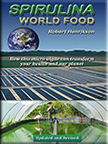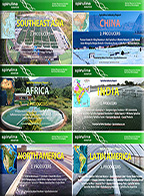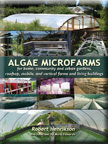Spirulina – Production & Potential.ISBN 2-85744-853-X.
by Ripley D. Fox. 1996. Pub. by Editions Edisud, La Calade, R.N.7, 13090 Aix-en-Province, France.
This book gives the most complete and practical information on growing spirulina. It should be consulted by health authorities and development decisionmakers, by spirulina growers and it can be used as a teaching text in universities. Dr. Fox explains the history of the cyanobacteria, Arthrospira platensis, popularly known as the blue-green algae spirulina… its composition, growth requirements and methods for managing the culture (from village level artisanal production to large scale industrial farms). Health benefits are described, with emphasis on its usefulness for combatting malnutrition. Giant farms using seawater are proposed for providing spirulina as a food supplement for the millions of malnourished children living today. Dr. Fox sees spirulina as a million dollar commodity in the near future.
Cultivez Votre Spiruline – Manuel de Culture Artisanale de la Spirulina.
by Jean-Paul Jourdan. 1996. Mialot, France. (in French). English version Pub. by Antenna Technology, 1999.
The author has been developing small scale spirulina projects in Europe and Africa. In this manual he describes how to cultivate spirulina on a family scale.
Spirulina Platensis (Arthospira) Physiology, Cell Biology and Biotechnology. ISBN 0-7484-9674-3.
Edited by Avigad Vonshak, Ben Gurion University, Israel. 1997. Pub. by Taylor & Francis, Rankine Road, Basingstoke, Hants RG24 8PR UK.
Spirulina is a form of blue-green algae which is becoming commercially cultivated on an increasingly large scale. This book describes the biology, cultivation and applications of this increasingly valued microorganism. It begins by examining the morphology, physiology, photosynthesis and genetics of laboratory cultures of Spirulina and then moves on to discuss the biotechnological applications in detail. An overview of mass production is also given. Written by leading experts in the field, this book will be an invaluable reference for researchers and industrialists working with this micro-algae.
Earth Food Spirulina: How this remarkable blue-green algae can transform your health and our planet. ISBN 0-9623111-0-3.
by Robert Henrikson. 1989, Revised 1997. Pub. by Ronore Enterprises, Inc. PO Box 71024, Richmond, CA 94807 USA.
This book has been called the “definitive popular reference book about spirulina.” Take a step-by-step adventure with this microscopic algae: how this 3.6 billion year old life form was rediscovered by scientists; its unusual phytonutrients and antioxidants; how spirulina can benefit your health through self care programs; new medical discoveries revealing spirulina’s health benefits; how it ecologically grows more nutrition per acre than any other food; how spirulina is grown in the developing world countries; how it uses land and water more efficiently than other crops; what super spirulina and phytochemical extracts to expect in the near future; schemes and dreams to restore our planet with micro algae. This easy-to-read 180 page book has over 100 photographs, charts and graphs, and an 11 page scientfic bibliography. To order Earth Food Spirulina.
Production of high quality spirulina at Earthrise Farms.
by Amha Belay and Yoshimichi Ota. 1994. Pub. in Proc. of Second Asia Pacific Conference on Algal Biotech. Univ. of Malaysia. USA.
Earthrise Farms, a subsidiary of Dainippon Ink & Chemicals Inc. is the largest open pond algal farm in the world. The dried spirulina powder is sold in the USA and almost all continents as a human food supplement, as food coloring, and as animal and aquaculture feed. As in the case for other algae products, no single market can support the farm. Producing high quality spirulina that meets the demands of varied customers is the key to economic success. This requires good management practices during culturing, harvesting, drying and packaging. The finished product must satisfy strict quality guidelines set by different authorities in the countries where it is sold. The successful production of high quality spirulina at Earthrise Farms is the outcome of over ten years of research and development. This paper discusses the problems associated with production and quality control in a historical perspective. The current state of production worldwide is also reviewed.
Spirulina Industry in China: Present status and future prospects.
by Ding-Mei Li, Yu-Zao Qi. State Science and Technology Commission of China, Beijing. Institute of Hydrobiology, Jihan University, Guangzhou. 1997. Pub. in Journal of Applied Phycology 9: 25-28, 1997.
The spirulina industry in China is developing rapidly as a national strategic programme. Currently, there are more than 80 production factories, with a total annual production of more than 350 tons dry powder and total production area of over 10 6 m2. Spirulina products are being used as food, forage and medicine. The low unit area output and non-consistent product quality call for further research on photosynthesis, strain selection and photobioreactor development as well as product standardization and quality assurance.
Spirulina (Arthrospira): potential application as an animal feed supplement.
by Amha Belay, Toshimitsu Kato, Yoshimichi Ota. Earthrise Farms. PO Box 270 Calipatria CA 92233 USA. Dainippon Ink & Chemicals, Tokyo Japan 1996. Pub. in Journal of Applied Phycology 8: 303-311, 1996.
Spirulina has been used as a human food supplement for over 20 years, but its use as an animal feed supplement is relatively recent. This paper reviews earlier studies on its more established effects on growth, survival and tissue quality in a whole range of animals and more recent studies on its immunomodulatory, anti-viral and anti-cancer effects. The basis for potential application as an animal feed supplement is discussed.
Commercial production of microalgae in the Asia-Pacific rim.
by Yuan-Kun Lee. Department of Microbiology, National University of Singapore, Lower Kent Ridge Road, Singapore 119260. 1997 Pub. in Journal of Applied Phycology, 1997.
There are around 110 commercial producers of microalgae in the Asia-Pacific region, with annual production capacity ranging from 3 to 500 tons. About nine-tenth of the algae cultivation plants are located in Asia. The commercially cultivated microalgae include Chlorella, Spirulina, Dunaliella, Nannochloris, Nitzschia, Crypthecodinium, Schizochytrium, Tetraselmis, Skeletonema, Isochrysis and Chaetoceros. Most of the commercially produced algae biomass is being marketed as health food, in the forms of tablets and capsules. Algae and their extract are also included in noodles, wine, beverages, breakfast cereals and cosmetics.
Production of Spirulina rich in GLA and sulfolipids.
by Hubert Durand-Chastel. Senateur des francais etablis hors de France. Palais du Luxembourg, 15 Rue de Vaugirard 750006 Paris France. Pub. in International Symposium Marine cyanobacteria and related organisms, Institute Oceanographique, Paris Nov. 1997.
Spirulina is a blue-green microalga (cyanobacterium) rich, relative to other sources, in the polyunsaturated fatty acid gamma-linolenic acid, said to have medicinal properties. It has been used for the treatment of hypercholesterolemia, atopic eczema and for alleviating symptoms of premenstrual syndrome. Moreover it is thought to have a positive effect in heart diseases, arteriosclerosis and pancreatic cancer. Besides, Spirulina like other cyanobacteria, contains anti-HIV sulfolipids. A process for the mixotropic production of Spirulina with a high concentration of GLA and / or sulfolipids was found to contribute to the improvement of GLA and sulfolipid contents in spirulina biomass. The environmental conditions (temperature. light intensities, light/dark cycles, FA precursors and other exogenous factors) have a major effect on the fatty acid composition. The lipid content of spirulina biomass increased and reached from 7 to 9% of dry weight compared with 5-7% of dry weight of spirulina produced by other processes. Especially the GLA and sulfolipid contents also increased significantly and reached 25-36% of total fatty acids and 39%-42% of total lipids respectively.
Spirulina National Symposium (India).
Edited by C.V. Seshadri and N. Jeeji Bai. 1992. Pub. by Shri AMM Murugappa Chettiar Research Centre (MDRC), Photosynthesis and Energy Division, Tharamani, Madras, 600 113, India.
ETTA National Symposium: Ecology, Taxonomy, Technology and Applications. Status report of the All-India Coordinated Project on the mass culture of spirulina: (a) large scale nutritional supplementation with spirulina; (b) feasibility report for suitable-sized plants; (c) maintenance of germplasm and quality improvement; (d) preparation of formulas and testing for various applications. Includes conference papers and Indian Food Grade Standards for Spirulina.
Algoculture: la, spirulina, un espoir pour le monde de la faim. (Algoculture: Spirulina, hope for a hungry world.) ISBN 2-85744262-9.
by Ripley D. Fox. 1986. Pub. by Edisud, Aix-en-Province, France (in French).
Dr. Ripley Fox pioneered village scale spirulina systems in developing world countries. He decribes what conditiona and nutrients needed to grow spirulina. He describes the installation and operation of his integrated village health and energy system in three experimental projects.
Biotechnology & Utilization of Algae: The Indian Experience.
by L.V. Venkataraman and E.W. Becker. 1985. Pub. by Sharada Press, Mangalore, India.
Spirulina, Algae of Life. ISBN 0304 5722.
April 1993. Bulletin Special No. 12. Pub. by Institute Oceanographique, Monaco. (in French).
Reports of spirulina cultivation around the world presented at the Monaco Oceanographic Institute, 1993. Introduction of Spirulina, the algae of life by Hubert Durand Chastel. Reports on spirulina production in Mexico, India, Spain, Myanmar, Chile and developing countries.
Micro-Algal Biotechnology.
edited by Borowitska. 1986. Pub. by Cambridge University Press, Cambridge, UK.




